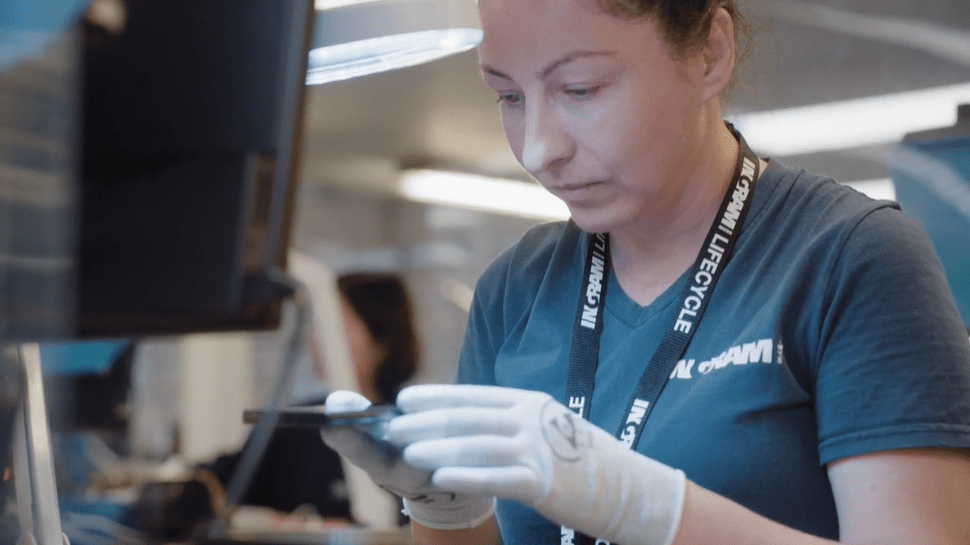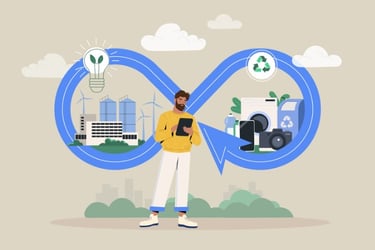The demands of the technology market are changing. As the needle shifts from an ownership economy to a sharing economy, you must keep up with market requirements. You need to understand the implications of this for returns management and what the challenges may be.
Failing to remain agile and move with the market leads to dissatisfied customers, high volumes of depreciating returns, failed data security, and more.
Ingram Micro Lifecycle supports global returns management programs for manufacturers, retailers, and insurers.
Below, we outline some of the different returns management challenges faced due to the mindset change from ownership of devices to sharing of devices.
What’s driving this change?
Several factors are causing businesses and consumers to rethink their technology consumption. These include:
- Cost
- Availability of products
- Environmental concerns
- Improved warranties
- Higher quality preloved products
These factors are causing a drive for technology through Device as a Service solutions, subscription models, and leasing.
Why is efficient returns management important?
Returns management can be a complex process. Keeping the customer happy is the objective. Customer satisfaction is a sure way to guarantee the success of your business, regardless of whether they’ve bought a product from you or are leasing it.
Your goal is still to retain customers through brand loyalty and aim for peer referrals.
This is particularly true of the fast-paced technology market where products are ever-evolving with frequent exciting new models and products for end-users to take advantage of. Dissatisfied customers will look elsewhere – with your competitors.
Your returns policy and returns management can tip the scales when it comes to a good or bad customer experience. Handling these returns needs a robust management plan. Whether selling or leasing products, the approach needs to be different.
Data security
Before splitting off and looking at the challenges between the two categories of selling and leasing products, it’s important to note that both share challenges for the data security of returned data-bearing devices.
All parties must be diligent in their data-wiping processes regardless of whether the device is due for return to the customer or dispositioned ahead of recycling/entering the secondary market.
OEM accreditations will provide access to manufacturer-approved software for this.
The logistics of a product return, mentioned again below, must be secure in case of residual data.
A reliable logistics network ensures the product will reach you without delays or mistakes.
Sales challenges
Manufacturers or retailers desire sales growth and developing/promoting new sales lines. Customer satisfaction must be high to achieve this. Sometimes, it’s easier to allow flexible returns policies to encourage a higher satisfaction rate. A more generous returns policy often means more returns to manage. The following challenges then arise:
Logistics
The available network and space is needed to collect (situation dependent) and receive the returns once the customer has indicated their intentions to trigger the returns policy. This process should transpire quickly so the customer gets their satisfying resolution as rapidly as possible and also to combat potential depreciation.
This point applies to leasing products too.
Grading and assessment
When you receive the product back in the returns center, the product needs to be assessed to get to the bottom of the return cause.
It may be there’s nothing wrong with the product, and the customer changed their mind. If this is the case, the product can be rekitted and resold.
If a fault is found, you should work to limit the e-waste. This means identifying what parts need replacing and what repairs can be conducted. If you intend to do a same-unit repair, this must be done efficiently to get the working device back to the customer.
You must have access to the technical know-how, equipment, and parts to complete an efficient repair and refurbishment.
Returns need to be processed through your system quickly to either issue a refund for the customer, an exchange, or the return of the fixed device.
Grading and assessment occur as part of the leasing process when a device has been returned, ahead of being re-leased or dispositioned.
Recommerce opportunities
While the returned product is sitting on your balance sheet, it’s losing value. You must turn the product around quickly and look for potential value recovery. To recover maximum value, you need access to a secondary market network for reselling and understand market prices to ensure you get the best price.
Without a strong recommerce network, you risk losing additional money on the product from either selling it for too low a price or not having the platform to sell it on.
Recommerce is also an opportunity for leased products once there is a lower customer demand for the product.
Returns avoidance
Reduce the volume of returns by improving your remote technical support available to end users. Look for opportunities to encourage self-diagnosis of issues and remote fixes. Address the common issues being fed back to you, especially if these are user errors. If the customers can counter problems themselves, then it reduces the devices that you need to process in-house.
Perhaps you’re noticing that some customers just happen to experience a fault with their product not long before the warranty expires. You need to be able to identify remotely that the fault is genuine and not an attempt to take advantage of the returns policy.
There could be an opportunity for you to supply, where relevant, a replacement part instead of a whole product exchange. This means you need an understanding of the problem and access to the parts. Your customer contact center should be able to report back as much information as possible so you to make an informed decision on whether the full product return needs to happen.
The customer advisors also need a detailed understanding of the product to be able to assist customers with remote repairs and guidance.
Leasing companies should also look to offer remote support for products in contract.
Leasing challenges
Customer use of the product is for a specified amount of time, as detailed in their leasing contract. Therefore, there’s a degree of forecasting available for your returns management.
You can see when each contact is due to end and how many in each period. This enables a greater chance of accurately planning what returns processes are required. There will be a set process to follow for each product – the customer returns the product at the end of their contract, it gets graded and dispositioned. This gives you a regular and structured insight into any patterns forming with product issues that you can quickly counter or rectify.
Each product sits in your inventory. You’ll have insight into every product, model, condition, age, cost, and more, available on a live system. This gives greater awareness of when a product will no longer have a use in the market and requires recycling.
However, as there are differences in this model, there are different challenges:
Product range
Technology leasing companies may need to understand a wider range of products compared to manufacturers who focus on a specific niche or segment of the market. You’ll need access to a wider range of replacement parts, manuals, and repair capabilities – all from various manufacturers rather than just one brand. This may mean managing a more diverse supply chain.
Early contract leavers
While you can plan for the contract leavers that exit and return their product when expected, there will inevitably be some that exit unexpectedly. For example, within the cooling off period. These returns still need processing in the same way so you can get the units turned around for re-use.
Time restraints
Time may be of the essence for getting returns ready for their next lease cycle. Demand for a particular product or model may be high, depreciation and sustainability are reasons why it’s important to get products back out to their next user.
You need efficient management strategies in place to ensure that processing is as swift and accurate as possible.
The same applies if a product has been returned for repair before the next billing cycle. You need to minimize customer downtime to ensure their satisfaction doesn’t suffer. You need access to the technical know-how to quickly diagnose and fix the problem, ready to get the product back to the user.
Customer support
The relationship between you and your customer is ongoing and needs to be supported throughout the lifetime of their contract(s) with you. Unlike with buying a product, there may be times when you have additional contact. This includes lifetime product support.
The process for leasing a product must be simple, and so should problem-solving. The user of the product should experience as few barriers as possible should they have questions about their contract or use of the product. They should be able to access support wherever and whenever they are, so provide as many resources as possible to counter any frustration they may experience. Within reason, of course!
There will be support outlined in the contract the user signs so you’re obligated to meet those terms. Don’t overpromise and fail to deliver. Set expectations that you know you can meet, or even exceed. This means you need to hit specified timeframes for processing products and resolving issues.
Maintaining quality
The name of the game here is lifecycle extension. This means you have to maintain the use and functionality of the product for as long as possible. You need a robust process that can repair and refurbish the products after each use to ensure longevity.
You’ll maximize the return on each product the more you can lease, and it lowers the carbon footprint of a user’s technology habits because they’re not buying a brand-new device each time.
By avoiding the purchase of new technology, and using refurbished equipment, 87% of greenhouse gas emissions associated with production are avoided.
It’s also important that the refurbished device you issue out on a contract is suitable for use throughout the full duration of the contract. Your customer won’t be happy if the device they’ve received needs to be exchanged mid-contract because the quality was sub-par.
Communication
With leasing devices, there are more links in the chain – you, your customer, a funder, plus any other third parties you might use for logistics, returns management, and repair and refurbishment. If you work with a 3PL like Ingram Micro Lifecycle, you cut out unnecessary links in the chain by getting an end-to-end solution.
The more links you have, the more you need to optimize your communications. Keeping everyone updated on pertinent matters is vital for smooth operation. Don’t fall into the trap of oversharing information but maintain just the right level so everyone knows what’s happening, particularly in the event of an issue.
Are you prepared for the challenges of returns management?
As you can see, handling the returns of leased products can be more intensive than when dealing with product sales. The customer relationship needs to be more thorough so requires additional care and nurturing. Time is much more of a factor and so is the disposition of products.
Partnering with a 3PL that can offer an end-to-end solution, like Ingram Micro Lifecycle, reduces the pressure on your business operations to diversify and split focus from business as usual. Ingram Micro Lifecycle has the technical know-how to manage returns for both product sellers, be it manufacturers or retailers, and leasing companies.
Get in touch with us today using the orange button below or by clicking here, and one of our team will respond as soon as possible.
Further reading:
- 7 reasons why consumers are switching from new to refurbished devices
- The rise of Device as a Service: why we're renting technology
- 10 benefits of switching to a DaaS model
- Device as a Service vs leasing: which is best for my business?
- 6 reasons why subscription models are on the rise
- 10 ways a lifecycle partner supports DaaS and leasing
- Tips for getting the most from your returns management partner













